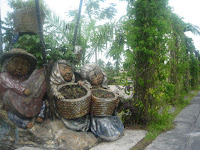'Discrimination still among us'
By Chelyn Torejas of Jose Maria College
DILI ko maulaw manglimos pero maulaw ko moadto og skwelahan (I am not ashamed to beg but I am ashamed to go to school," teenage Lino, a Badjao, said.
"Okay lang man ang teacher pero usahay ang classmate ang mo-kantyaw. Ingnon man silag, 'Badjao, Badjao'. Usahay pod dagko na sila, maong maolaw (The problem is not with the teachers but with the classmates. The children are being teased, branded as Badjaos. Others are ashamed because they are older than their classmates)," said Lolita Adjari, the leader in one of two Badjao communities in Matina Aplaya.
Leah Genson of the United Church of Christ in the Philippines (UCCP) Pag-ugmad sa Kabataan, which is operating a pre-school inside Adjari's community, and is also maintaining elementary scholars in nearby Matina Aplaya Elementary School, admits that discrimination is one of the issues being faced by their students.
But, they are trying to address this by sending their social workers to schools where the children experience such.
"Pinapaintindi sa mga estudyante ano ang mga Badjao," she said.
Discrimination persists, and the target of these, are not just the Badjaos, but Mindanao's other indigenous peoples as well.
"Daghang mga kasinatian anang discrimination. Akong magulang wala nakahuman og skwela kay magsige raman kakita og sumbagay (We have experienced discrimination. My brother even had to stop going to school because he would always find trouble from the constant teasing he got from his classmates)," Lucy Rico, a lumad and the Scholarship In-charge of Minadanawon Initiatives for Agricultural Dialogue said.
The teacher Rico added has the key role that can minimize if not totally stop discrimination as experienced by indigenous children at school.
Matina Aplaya Elementary School guidance counselor agrees. Equality, she said, should be fiercely taught in school.
Making sure that the marginalized get proper education, however, can help bring up not just their people's self-esteem but also their role in their communities, consequently bringing them the opportunity to lead and be heard which a meek, uneducated community may not readily take up.
"Mao gyud nay pinakagwapo kung mahuman gyud na sila. Gwapo mana paghuman nimog skwela syempre naa man gyud na mo-hire sa imoha (It is best if they, the Badjaos, will finish their studies. Simply because, if you have acquired education, you will have a greater chance of being employed)," Jonathan Irales, 26, said. Irales, son of a former leader of the other Badjao community in Matina Aplaya, is the only one in their community who has graduated in high school.
His case, however, should not be exceptional saying there are well-educated Badjaos in Sulu, Zamboanga and Tawi-Tawi who have college degrees. He proudly calls them as "professionals".
"Abi sa akong papa Tagalog, pero Badjao diay. Sila lay nagsupporta, gikan sa ilang katigulangan gipa eskwela gyud silag maayu (My father thought they were Tagalogs and did not recognize them as fellow Badjaos. Their parents and relatives are the ones who have been supporting their studies)," Irales said.
There are already existing programs in some cities in the country that address the education needs of Badjaos.
If Macau has a floating casino and fairy tales have floating castles, early this year, a floating school in Zamboanga City was established to suit the mobile lifestyle of Badjao children. This has been established to bring the school closer to the Badjao community instead of forcing Badjaos to go to school, taking into consideration their dependence on the seashore, boat-dwelling lifestyle and their language.
In Sulu, Marines have been instigating "Learn to Read and Write" program directly aimed for the Badjao community.
"Poverty is not a reason of not earning education. I have been in a poor family. I go to school with nothing. Poverty is not a hindrance towards education," said Bengaura, who was in the community paying a visit to the family of her Badjao student.
It is in recognition of the more difficult climb a child from an indigenous peoples' tribe has to go through to achieve basic education that programs designed especially for the IPs have been developed.
For one, the Department of Education established an Institute for Indigenous Peoples Education (IIPE) in 2004. Part of the program is an Alternative Learning System (ALS) intended for out-of-school children/ youth and adult population teaching basic literacy skills. It promotes its advocacy that learning can take place anytime and any place suitable for the convenience of the learners.
ALS is an alternative learning solution if one does not have an easy access with formal schooling due to its modular and flexible programs.
There is also the Mindanawon Initiatives for Cultural Dialogue, established in 2001, and is giving comprehensive college scholarship program among different indigenous people from different tribes who can pass the screening exam. The program which is actively supporting IIPE, Rico said, is currently supporting 14 scholars.
"Bisan dili namo kultura mo-eskwela daghan ang naningkamot tungod sa kausaban sa panahon tungod sa kalisod (Though studying is not in our culture, a lot strive to acquire it because of poverty and the changes brought by time)," Rico said.
Rico however admitted that the organization has not yet reached the Badjaos. "Sa pagkakaron daghan mang mga NGOs, sa government nga ginatotoakan sila (Badjaos). Ang among ginatabangan kato gyung layu katong walay naghatag og panahon (NGO have been giving an eye on Badjaos. Our organization is presently helping those tribes from far-flung areas that are not yet receiving help from any organizations," Rico added.
The embassy of Japan, in its official web portal, further affirmed its main support with the "Community Education Center" directed towards children and adult Badjaos in Isla Verde, Barangay 23-C, Davao City.
Wary of strangers
The Badjao group, however, believes they have been made use of and are thus wary of organizations extending help to them but have other agenda in mind. "Mao nay pinaka-number one namo nga kasuko kanang motabang pero wala (We are angry at those people who only makes good-for-nothing promises)," Adjari said.
Irales recalls how a group of people gathered them for a picture taking who explained that it would generate donations. Until today, the Badjaos from Matina have not received any donations from the group.
"Nakita na lang namo sa picture, gigamit rami (Until we saw our pictures. They only used us)," Irales said.
Education at the bottom-line
Lurking amid all these woes is still one basic right, the right to education that seemed to have been kept away from the Badjao children by their elders and by the society.
"Education is a societal concern and responsibility," Department oe Education Sectretary Jesli Lapus said in the "Give Us This Day" program of Pastor Apollo Quiboloy aired between 8-12 p.m. last November 19.
"Ang edukasyon makapa-usab gyud sa kinabuhi sa tawo depende sa imong pagdala kung naa gyud sa maayu nga dalan... Wala naman gani bugas mopa-eskwela pa kaha wala naman gani ikapalit og panihapon palit pa bag lapis. Kung naa man gani chance nga makaeskwela paningkamotan nga mapahimoslan ang tabang (Education can change one's life depending on how you used it. If there are chances, strive to benefit from those help)," Rico said.
"Education is one of the ways of life in this world. But the very essence is that in this world we need education because education gives a life to a person... there you will learn what is right, what is wrong and what is best how to do the work," Bengaura said.
"Usa na sya ka way nga ma assert ang among katungod kay kung dili mi moeskwela unya behind kaayu mi sa mga panghitabo, unsaon namo pag assert nga kami tawo, mao ni among tribu nga angay ninyung ilhon, unsaon namo pag-assert atong right nga nawala sa amoa (Education is one way that we can assert our right. We will be left behind if we will not go to school. How can we assert that we too are your people, that this is the tribe that you need to acknowledge and to assert our right that was lost)," Rico said referring to the importance of education among indigenous people.
Bengaura, however, said that while teachers can encourage children to study hard, the ultimate encouragement should come from the children's homes. The responsibility to motivate children to go to school lies with the parents, she said.
Unemployment breeds unemployment. In a competitive world, inefficiency due to lack of formal schooling and basic literacy skills is one reason that triggers it. In this community, the cycle continues.
When a need for education clashes with a way of living, the education programs can suffer an uphill climb. Though the Philippine constitution upholds the right of every Filipino for free basic education, complete cooperation and literal presence of the supposed-to-be-students are needed before it can address the learning needs of the marginalized just like with this community.































